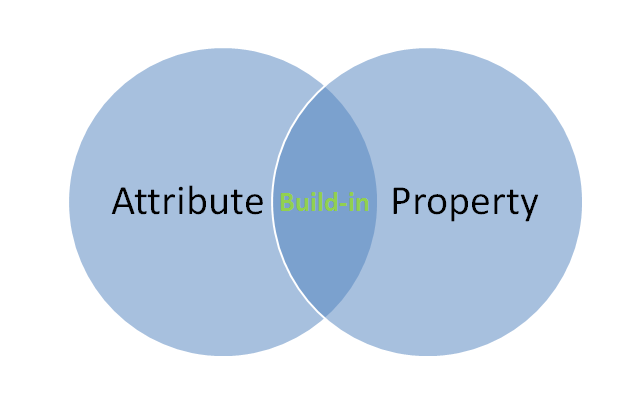Heim >Web-Frontend >js-Tutorial >jQuery的attr与prop使用介绍_jquery
jQuery的attr与prop使用介绍_jquery
- WBOYWBOYWBOYWBOYWBOYWBOYWBOYWBOYWBOYWBOYWBOYWBOYWBOriginal
- 2016-05-16 17:20:251280Durchsuche
attribute与property
attribute和property都可以翻译为属性,为了以示区别,通常把这两个单词翻译为属性与特性。
上面这段HTML语句中有三个节点,分别是Element “div”、attribute “id”、Text “click here”,我们最常见的attribute正式指的attribute类型节点,在JavaScript有专门处理attribute的函数 .getAttribute(name) / setAttribute(name,value)。当然attribute不只是我们能够在HTML文档上看到的这几个,我们可以自定义attributed加到DOM节点中
这样可以div被修改为
通过方法 setAttribute设置的attribute最终都会反映到元素的attribute类型的节点中
property是DOM对象的字段,跟我们平常使用的一些对象一样,包含很多字段,这些字段就是property,取值或者设置值和普通字段一样通过”对象.字段“的方式。
看起来attribute和property应该没有什么关系才对,怎么会。。。attribute和property容易混倄是因为很多attribute节点还有一个相对应的property属性,比如上面div的”id“ attribute 同样可以用t.id取到(实际上绝大部分人都是这样获取的),通过property更改id后,用getAttibute获取的id是更新后的id。
t.id='test1';
console.log(t.getAttribute('id'));//test1
同样我们也可以自定义property
t.customizedProp='customized prop';
区别
1. 于build-in属性,attribute和property共享数据,attribute更改了会对property造成影响,反之亦然,但是两者的自定义属性是独立的数据,即使name一样,也互不影响,看起来是下面这张图,但是IE6、7没有作区分,依然共享自定义属性数据

2. 并不是所有的attribute与对应的property名字都一致,比如刚才使用的attribute 的class属性,使用property操作的时候应该是这样className
3. 对于值是true/false的property,类似于input的checked attribute等,attribute取得值是HTML文档字面量值,property是取得计算结果,property改变并不影响attribute字面量,但attribute改变会一向property计算
var t=document.getElementById('test3');
console.log(t.getAttribute('checked'));//null
console.log(t.checked);//false;
t.setAttribute('checked','checked');
console.log(t.getAttribute('checked'));//checked
console.log(t.checked);//true
t.checked=false;
console.log(t.getAttribute('checked'));//checked
console.log(t.checked);//false
4. 对于一些和路径相关的属性,两者取得值也不尽相同,但是同样attribute取得是字面量,property取得是计算后的完整路径
var t=document.getElementById('test4');
console.log(t.getAttribute('href'));//#
console.log(t.href);//file:///C:/Users/bsun/Desktop/ss/anonymous.html#
关于浏览器(IE)造成的兼容性问题可以看看IE 混淆了 DOM 对象属性(property)及 HTML 标签属性(attribute),造成了对 setAttribute、getAttribute 的不正确实现
attr和prop
相信看完上面内容,大家就明白为什么jQuery要添加prop方法了,在jQuery API中也有专门解释
Attributes VS. Properties
在一些特殊的情况下,attributes和properties的区别非常大。在jQuery1.6之前,.attr()方法在获取一些attributes的时候使用了property值,这样会导致一些不一致的行为。在jQuery1.6中,.prop()方法提供了一中明确的获取property值得方式,这样.attr()方法仅返回attributes。
比如,selectedIndex, tagName, nodeName, nodeType, ownerDocument, defaultChecked, 和defaultSelected应该使用.prop()方法获取/设置值。 在jQuery1.6之前这些不属于attribute的property需要用.attr()方法获取。这几个并没有相应的attibute,只有property。
关于布尔类型 attributes,比如一个这样的HTML标签,它在JavaScript中变量名为elem
| elem.checked |
true (Boolean) Will change with checkbox state |
| $( elem ).prop( "checked" ) |
true (Boolean) Will change with checkbox state |
| elem.getAttribute( "checked" ) |
"checked" (String) Initial state of the checkbox; does not change |
$( elem ).attr( "checked" ) (1.6)
|
"checked" (String) Initial state of the checkbox; does not change |
$( elem ).attr( "checked" ) (1.6.1+)
|
"checked" (String) Will change with checkbox state |
$( elem ).attr( "checked" ) (pre-1.6)
|
true (Boolean) Changed with checkbox state |
根据W3C forms specification,checked属性是一个布尔值,这就意味着只要checked属性在HTML中表现出来了,那么相应的property就应该是true,即使checked没有值,这点儿对其它布尔类型的属性一样适用。
然而关于checked 属性需要记住的最重要的一点是:它和checked property并不是一致的。实际上这个attribute和defaultChecked property一致,而且只应该用来设置checkbox的初始值。checked attribute并不随着checkedbox的状态而改变,但是checked property却跟着变。因此浏览器兼容的判断checkebox是否被选中应该使用property
if ( elem.checked )
if ( $( elem ).prop( "checked" ) )
if ( $( elem ).is( ":checked" ) )
这对其它一些类似于selected、value这样的动态attribute也适用。
在IE9之前版本中,如果property没有在DOM元素被移除之前删除,使用.prop()方法设置DOM元素property(简单类型除外:number、string、boolean)的值会导致内存泄露。为了安全的设置DOM对象的值,避免内存泄露,可以使用.data()方法。
使用场景
其实明白了上面讲的内容,什么时候该使用.attr()什么时候该使用 .prop()就很清楚了,不过还是传一张坊间很流行的图

In Verbindung stehende Artikel
Mehr sehen- Eine eingehende Analyse der Bootstrap-Listengruppenkomponente
- Detaillierte Erläuterung des JavaScript-Funktions-Curryings
- Vollständiges Beispiel für die Generierung von JS-Passwörtern und die Erkennung der Stärke (mit Download des Demo-Quellcodes)
- Angularjs integriert WeChat UI (weui)
- Wie man mit JavaScript schnell zwischen traditionellem Chinesisch und vereinfachtem Chinesisch wechselt und wie Websites den Wechsel zwischen vereinfachtem und traditionellem Chinesisch unterstützen – Javascript-Kenntnisse

